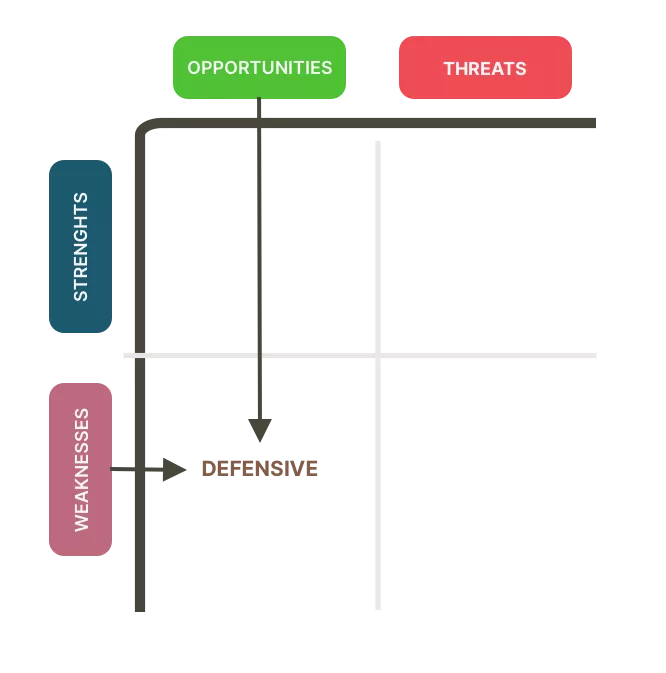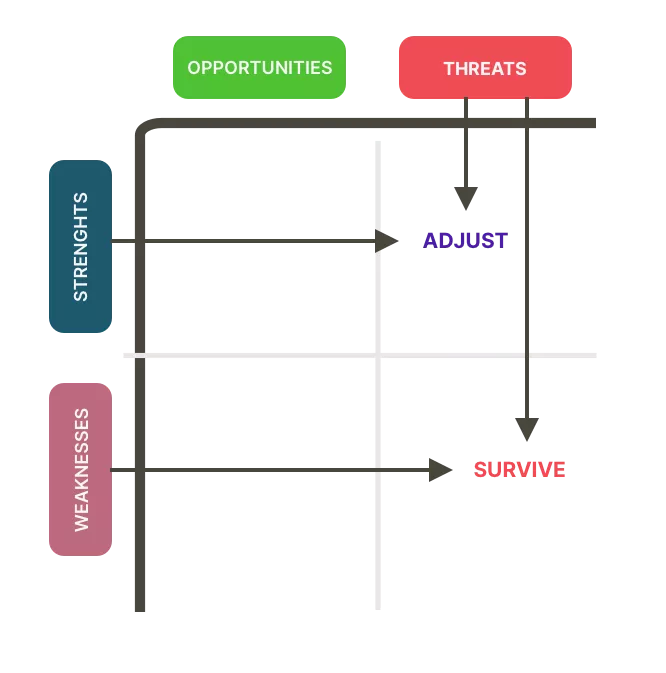Before marketing can implement strategies to improve the company’s position, the current situation of the company with its environment should be known. A SWOT analysis is an effective tool to evaluate the strategy.
The popular SWOT analysis is an overall evaluation of the company’s strengths (S), and weaknesses (W), as opposed to opportunities (O) and threats (T). Strengths and weaknesses are internal and arise from a micro-analysis. The latter analyses the company itself. On the contrary, opportunities and threats are in the environment and therefore external. They may result from a macro analysis.
Based on the SWOT analysis, strategies can be identified to deal with every potential situation in the best way.
Strengths include internal capabilities, resources as well as positive factors that may help the firm achieve its objectives and serve its customers. What is the company good at? What does it do extraordinarily well, and which unique resources does it possess? Examples include the image of a company, its quality, or cutting-edge design. Things it does particularly well. Strengths are within the organization’s control.
Weaknesses refer to internal limitations. They are negative factors that may hinder or interfere with the firm’s performance. What does the company lack in terms of resources and capabilities? And in what way is it limited in reaching its objectives? Examples may be too high costs that force the company to maintain high prices, or bad social image because of pollution. As strengths, weaknesses are within the organization’s control and can therefore be eliminated.
Opportunities are, as indicated before, favorable factors or trends in the external environment. They may be available for the company to exploit to the firm’s advantage. What factors are in the environment that present a unique chance for the company?
Examples are that there is a trend in the market for electric cars which is favorable for a manufacturer of electric cars. As an external element, the organization can normally not take influence or even control opportunities. However, it can react to them.
Finally, threats are unfavorable factors in the external environment. They may present obstacles or challenges for the company. What factors in the environment make it difficult for the firm to reach its objectives?
This might be sociocultural burdens, governmental restrictions, or competition. As counts for opportunities, threats are also external elements that the company cannot control. Therefore, it has to adapt its reaction to the threats.
Just investigating strengths, weaknesses, opportunities and threats apart from each other does not help too much. It is only half of the SWOT analysis. Only when internal factors are combined with external factors, the SWOT analysis can be used to full advantage. The key is to combine strengths and opportunities to gain maximum advantage. At the same time, eliminate or overcome weaknesses and guard against or minimize threats.
Four basic strategies to meet the four elements of the SWOT analysis can be identified. To find them, each element is combined with each of the other ones. A strength can meet an opportunity, but also a threat. The resulting strategies are based on the following assumptions:

The first strategy derived from the SWOT analysis is called Offensive. If a strength meets an opportunity, the most favorable situation occurs. Indeed, a positive internal factor can be combined with a favorable external factor. This reveals the needed strategy: Offensive. This indicates that the company should make the most of this favorable situation. An example: if the company has low costs and can therefore maintain low prices, and the market demands low-priced products, make the most of this situation: penetrate the market.

Secondly, the SWOT analysis leads to a Defensive strategy. In case of a weakness meeting an opportunity, careful consideration is required. The situation presents a risk, against which the company should defend itself. Consequently, the defensive strategy involves that the organization must watch the competition closely. By doing that, it can ensure that its weakness does not hinder its success in the future. For instance, if the firm has high costs and must therefore maintain a high price level relative to the competition, but the market’s demographics offer a high wealth in terms of disposable income, etc., the company should better defend against this potentially dangerous situation. Although it may not be a problem in the first place, it could become one if it is not taken care of appropriately.

Eventually, the SWOT analysis may reveal situations where strategies of Adjust or Survive are required.
If a strength meets a threat, a positive internal factor meets a negative factor in the environment. The result is the Adjust strategy, which means that the company must make full use of its strengths to be able to overcome and neutralize the threat. For example, a company may have a high pricing power. This means that people will keep buying its products regardless of changes in the price. However, the market’s wealth could be decreasing. This must be considered a threat to high-priced products. Thus, the company should fully use its strength to overcome the threat. How can it play with its prices to outrun the danger?
If a weakness meets a threat, the worst case is reached. It means that a negative internal factor is met by a negative external factor. The resulting strategy is to Survive. This means that the company has to spend utmost attention on carefully managing the situation. It has to be more than aware of the threat. If needed, turn around and adapt to prevent a potential disaster.
An example is the high prices of a company that cannot be varied due to fixed costs etc. If this is met by a market that does not accept high prices but only seeks low-cost products, there is only one way: turnaround. This could be done by either exiting the market and focusing on another one or by redesigning the internal processes to be able to offer lower costs.
The SWOT analysis has great potential and can help a business to better understand itself and its environment. Therefore, the SWOT analysis is a very popular tool. As we can learn from these four strategies, the company can gain the most when a strength meets an opportunity. However, other, less favorable situations do not mean that all is lost.
The crucial point is that the firm has to reach the situation and make the most of it. Then, the SWOT analysis provides an effective approach to dealing with the company’s strengths and weaknesses in an environment that offers opportunities and poses threats.
If you just sit at your table alone and try to come up with one element for each SWOT category, I’m not sure it’s going to be very productive.
A SWOT analysis gives the best results when you brainstorm with your whole team.
First off, make sure everyone understands what constitutes a strength, weakness, opportunity, and threat. Maybe make them all read this article 🙂
Then, set up 4 different whiteboards, one for each category. This makes it much easier to focus. Now it’s time for the questions.
Ask open-ended questions to encourage critical and creative thinking in your team. Encourage everyone to:
Try using the “round-robin” suggestion method. You all sit in a circle and everyone gives their ideas, one by one. Also, everyone writes down each idea, so you do multiple rounds – until every idea has been explored multiple times and everyone has said what they think.
Another method you can use is the Force Field Analysis method. This approach involves examining the forces that help or hinder a decision or change. Simply divide a whiteboard into two halves – “Driving Forces” and “Restraining Forces”. Evaluate the strength of each force on a scale (e.g., 1 to 5, where 5 is very strong) and see if a decision is worth pursuing.
When conducting a SWOT analysis, it’s important you compare your organization’s performance to that of your competitors. Here’s how to effectively achieve this comparison:
Make informed decisions: Use the findings to make strategic adjustments. This might involve reformulating marketing strategies, improving customer service, or investing in technology.

Email subscription is available ONLY TODAY (oh, okay, and tomorrow).
Surely, we respect your inbox! Unsubscription works every day.

We’d love to tailor your experience — which of these best describes you?